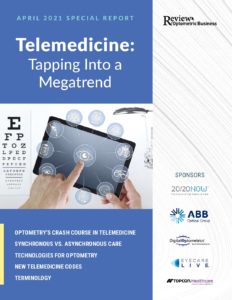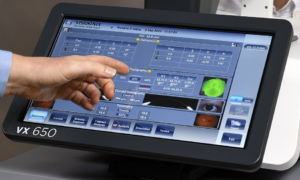By John Sailer
Editor-in-Chief
Jobson Medical Information
A new special report highlighting how telemedicine has been implemented in optometry has been produced by Jobson Optical Research. Click HERE to read the full report.
Telemedicine is so new that eyecare professionals are still debating what to call it. Telehealth? Telemedicine? Tele-optometry? The options funnel down from broad to narrow. (Review of Optometric Business has settled on “telemedicine” based on the guidance of ROB’s Professional Editor, Mark R. Wright, OD.)
The use of telemedicine exploded in nearly all medical professions when the COVID pandemic hit because doctors and patients still needed to see each other during stay-at-home orders. Nationally, federal regulations were eased, and even eyecare organizations such as the American Optometric Association and the National Association of Vision Care Plans changed their positions.
Download New Report
To understand where we are on the trajectory of the implementation of telemedicine technology in optometry, Review of Optometric Business and Jobson Optical Research surveyed ECPs – about half currently using telemedicine and about half not, both in the middle of the pandemic (July 2020) and now as we emerge from it (January 2021).
Here are some of the survey highlights:
• Most ECPs using telemedicine in July 2020 (48 percent) continued using it in January 2021 (44 percent).
• A large majority of ECPs using telemedicine did so because of COVID-related stay-at-home orders (88 percent in July 2020 and 90 percent in January 2021). Many plan to continue to do so.
• Those who plan to continue using telemedicine post-pandemic changed little (72 percent in July 2020 and 69 percent in January 2021) and represent a substantial two-thirds of respondents.
• ECPs using telemedicine are gradually moving from conducting telemedicine visits from home to in-office as the pandemic subsides.
• Patients satisfied or very satisfied with their telemedicine visits remains high, at a combined 75 percent in July 2020 and 70 percent in January 2021.
• ECPs figured out how to get paid for telemedicine; those citing “low reimbursement” as a reason for not using it declined a substantial 19 percent from 31 percent in July 2020 to 12 percent in January 2021.
• As telemedicine is implemented more, it is perceived as less of a threat to traditional optometric practice, both among those who are using it (down 8 percent from 31 percent in July 2020 to 23 percent in January 2021) and those who are not using it (down 6 percent from 41 percent in July 2020 to 35 percent in January 2021).
• However, both ECPs who are using telemedicine and those who are not using it are less sure about whether it is good or bad for the profession (unsure ECPs increased by 5 percent in both groups from July 2020 to January 2021), indicating a need for more education on the topic of the use of telemedicine in optometry.
This need among ECPs for more education about telemedicine is further supported by the survey results that show a majority still don’t know the difference between synchronous vs. asynchronous telemedicine.
 |
Learn more on how Eye Care Professionals are using telemedicine thru the pandemic in the Jobson Telemedicine Research Report. This research was run in July 2020 and again in Jan 2021 and trends are shown in this report. Click here for more information. |

John Sailer is editor-in-chief of Review of Myopia Management and Special Projects. To contact him: jsailer@jobson.com




























